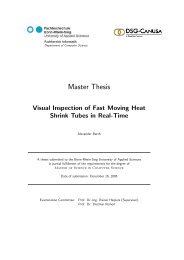Master Thesis - Hochschule Bonn-Rhein-Sieg
Master Thesis - Hochschule Bonn-Rhein-Sieg
Master Thesis - Hochschule Bonn-Rhein-Sieg
Create successful ePaper yourself
Turn your PDF publications into a flip-book with our unique Google optimized e-Paper software.
4. Overall evading concept <strong>Master</strong> <strong>Thesis</strong> Björn Ostermann page 52 of 126<br />
Speed control<br />
from<br />
part 1<br />
10<br />
Drive by<br />
Approach<br />
Acquire<br />
distance<br />
between robot<br />
and objects<br />
from Data<br />
Exchange<br />
Object<br />
Calculate speed from<br />
distance<br />
Set robot’s speed to<br />
new value<br />
Path planning<br />
9<br />
Drive by<br />
reachable<br />
space<br />
Acquire the<br />
reachable<br />
space from<br />
Data Exchange<br />
Object<br />
Transpose<br />
coordinates<br />
Select significant part<br />
of the map<br />
Calculate the<br />
shortest free path<br />
Obstacle<br />
in direct<br />
path<br />
Load<br />
evasion goal<br />
pose<br />
Set movement to<br />
direct drive mode<br />
Figure 32: Flowchart path planning control thread – part 2<br />
processing the environmental data (see Figure 25) in path planning routines<br />
The first subpart is the speed control, which is dependant on the distance between the robot and<br />
dynamic objects intruding into the workspace. It can be activated by the user (button 10), who<br />
automatically activates the acquisition of the required distance data as well. The data is transmitted via<br />
the data exchange object. This subpart acquires the data and changes the robot’s current speed<br />
accordingly, using the algorithm described in chapter 5.4.<br />
The next subpart, which requires the most computational effort in this task, is the path planning. It is<br />
activated by the user (button 9) if the robot is meant to evade intruding objects. As above, the<br />
activation of this subpart automatically activates the respective subpart of the camera control thread as<br />
well. The space the robot is able to reach, calculated by the camera thread, is acquired from the data<br />
exchange object. Since the coordinates of this space are still in the camera’s coordinate system, they<br />
have to be transposed into the robot’s coordinate system (see chapter 5.5.2). After this step, the<br />
significant part of the workspace, the part in which the movement takes place, can be chosen by an<br />
algorithm (see chapter 5.5.4). Based on the data about this significant part, the current pose of the<br />
robot and the next goal pose, another algorithm (see chapter 5.5.5) calculates the shortest free path,<br />
divided into sub-goals connected by straight lines, from the current pose to the goal pose around the<br />
part 3














